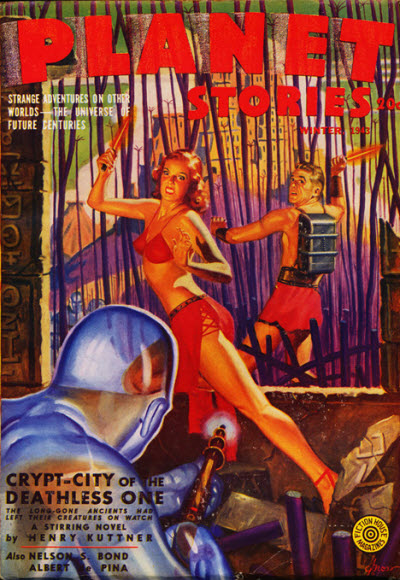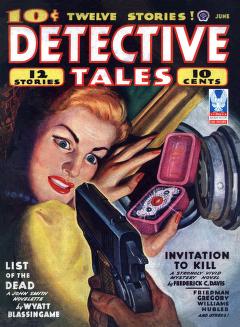By Wilbur S. Peacock (1911/15-1979).
First appearance: Planet Stories, Winter 1943.
Short story (11 pages).
Online at Project Gutenberg (HERE).
(Parental note: Mild profanity.)
"One man had to die on Uranus' frozen crust, so that the other might live."
The perfect place for murder: millions of miles from the heavily traveled space lanes. The perfect plan: murdering your partner, claiming it was an accident, and cashing in on a fortune in kronalium. The only problem: the unforseen; the unanticipated elements that, in this instance, leave "plans in an awful mocking silence" . . .
Major characters:
~ Tom Headley:
". . . worked with the quiet sureness of a man whose life had been self-sufficient."
~ Bart Caxton:
". . . worked with the grim doggedness of a man who knows that his life hinges
upon his speed in working."
Typo: "three graves" [probably gravs was meant].
Resources:
- While the planet Uranus hasn't been showcased in SFF as often as Venus, Mars, and so forth, it has appeared surprisingly often; see Wikipedia (HERE) for scientific fact about Uranus and (HERE) for science fiction about same. Does it rain diamonds on Uranus?
See Wikipedia (HERE) for that speculation.
- The FictionMags thumbnail about Wilbur Scott Peacock: "Editor, writer of short stories and television scripts. Born in Kansas; died in Los Angeles, California." Peacock cruised through the usual pulp venues, ambidextrously producing Westerns, crime fiction, and SFF with equal ease. Also see the ISFDb (HERE) and the IMDb (HERE).
- Another pulpy Planet Stories concoction by Peacock is "Spider Men of Gharr," online at Comic Book Plus (HERE; select page 56 from the dropdown menu).
- Several Hollywood films with somewhat similar situational and character set-ups but entirely different settings and resolutions are discussed (SPOILERS: HERE, HERE, and HERE).
~~~~~~~~~~~~~~~~~~~~~~~~~~~~~~~~~~~~~~~~~~~~~~~~~~~~~~~~~~~~~~~~~~~~~~~~~
The perfect place for murder: millions of miles from the heavily traveled space lanes. The perfect plan: murdering your partner, claiming it was an accident, and cashing in on a fortune in kronalium. The only problem: the unforseen; the unanticipated elements that, in this instance, leave "plans in an awful mocking silence" . . .
Major characters:
~ Tom Headley:
". . . worked with the quiet sureness of a man whose life had been self-sufficient."
~ Bart Caxton:
". . . worked with the grim doggedness of a man who knows that his life hinges
upon his speed in working."
Typo: "three graves" [probably gravs was meant].
Resources:
- While the planet Uranus hasn't been showcased in SFF as often as Venus, Mars, and so forth, it has appeared surprisingly often; see Wikipedia (HERE) for scientific fact about Uranus and (HERE) for science fiction about same. Does it rain diamonds on Uranus?
See Wikipedia (HERE) for that speculation.
- The FictionMags thumbnail about Wilbur Scott Peacock: "Editor, writer of short stories and television scripts. Born in Kansas; died in Los Angeles, California." Peacock cruised through the usual pulp venues, ambidextrously producing Westerns, crime fiction, and SFF with equal ease. Also see the ISFDb (HERE) and the IMDb (HERE).
- Another pulpy Planet Stories concoction by Peacock is "Spider Men of Gharr," online at Comic Book Plus (HERE; select page 56 from the dropdown menu).
- Several Hollywood films with somewhat similar situational and character set-ups but entirely different settings and resolutions are discussed (SPOILERS: HERE, HERE, and HERE).
~~~~~~~~~~~~~~~~~~~~~~~~~~~~~~~~~~~~~~~~~~~~~~~~~~~~~~~~~~~~~~~~~~~~~~~~~













































